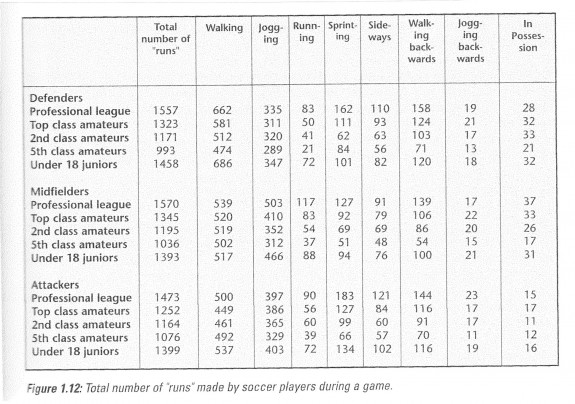It will take a lot more than fitness for the USMNT to win the World Cup
What kind of fitness do soccer players need to play World Cup soccer?
Here’s what you have to be able to do:
- Run 6-8.5 miles in a 90 minute game.
- Make 1400-1600 “runs” per game, including…
- Sprinting 10-30 yards, 20-40 times per game.
- Sprinting 1-10 yards, 100-120 times per game.
- That’s 2-3 per minute all game long.
- Add 15% effort if you’re carrying the ball.
This varies a bit by position:
- Midfielders typically cover the most ground, working to support the defense and the attack and connect the two.
- Defenders do a bit more walking and less jogging, as they have time while the attacking players are in command.
- Attacking players adopt more sprinting runs to create space and chances to receive and play the ball.
- Wingers may make more and longer runs.
- Defensive midfielders may do more holding.
Then it varies by country and team style:
- Teams who build the attack out of the back with many small linking passes include nearly all players in a nearly continuous effort.
- Teams who bypass the midfield with long balls over the top let the ball do the work, so to speak, along with a target player or two.
- Teams that change the pace of play regularly require greater endurance than teams that keep a steady pace.

Source: Conditioning for Soccer, Dr. Raymond Verheijen
So, it’s not simple. In fact, it’s pretty unpredictable. But that doesn’t keep sport scientists from trying to analyze it all and use it to our team’s advantage. Can fitness win soccer games?
Well, we know that poor fitness can lose soccer games. In tight games, played at high temperatures, under brutal conditions, extending through overtimes and double overtimes, certainly the unfit are sifted out and tossed aside. Coach Jurgen Klinsmann wants to avoid that at all costs. Fitness is one thing he can control in the preparation of his team.
And fitness is our strength in America. We are “good athletes.” By that definition of fitness, we are fit, maybe even the fittest in the world. But on the world stage, that’s not good enough. Everyone is a good athlete. Athleticism is required but not sufficient for performance there. We need more.
Redefining “Fitness”
This is where we need a new definition of fitness. Most use it to mean physical conditioning for sport. We do focus on physical conditioning in our youth competitive ranks, for sure. The club coach has the team running suicides and gutting out grueling field sessions figuring “that team may be more skilled than we, are but we’ll be ‘fitter,’ and that will make us winners.” What he doesn’t say is that he is avoiding the embarrassment of lacking in fitness. That would be so un-American!
That’s where America is short-sighted and a bit naïve in the way we think of fitness; fitness doesn’t exist without an object. We need to ask, fit for what? Repeat sprints may win track meets, power plyometrics may win jump balls, and bicep curls may win admiration, but none of those will win you a World Cup.
Fitness for sport means being prepared for the demands of that sport. This is complex for soccer, because there are so many demands. How do you train for that?
Player development in this country focuses on the “4 pillars”: psychological, physical, technical and tactical training. The physical comprises what we usually think of as fitness: endurance, speed, agility, power, strength. But that’s not much good on its own. If we just wanted explosive, fast guys, why not recruit track athletes and teach them some soccer? It works for the bobsled.
I find Charles Darwin’s definition of fitness helpful here: “Fitness is the ability to survive, reproduce and adapt in a specific environment.”
Do we have players with the ability to adapt to conditions, produce goals and survive the withering attack of other teams? If Klinsmann is going to get all that done, the last thing he wants to concern himself with is whether his players are physically well-conditioned. But that won’t win a World Cup. Physical fitness just prepares them. It sets the stage for the rest.
Fitness for Performance
The question is whether they can ply their trade on demand. When demanded, do they have the speed? When demanded, do they have the technique? When demanded, do they have the patience, do they see the space, do they execute the pass? That’s fitness with an objective: to perform. Oh yeah, and perform better than the best in the world. Now we’re talking fitness with an international flavour.
Performing on demand is a tall order, though. You know this if you’ve ever played the game. It’s why I gnash my teeth (and sometimes fail to hold my tongue) when I hear parents shouting “Shoooot!” at their kids on the pitch. Unlike when they were toddlers and we relished getting them to “perform on cue,” this performance fitness needs to come from them. We can’t teach it to them; the game will demand it from them. Players must, in an instant, work out balance, opportunity, favored foot, positioning, speed, acceleration, force, torque… all while they may very well be re-living the last shot they missed or day-dreaming about their date for the prom. The more demanding the game and the stronger the opponent, the quicker the decisions have to be made.
Imagine what that’s like in the World Cup. Just a few distractions to be tamed there.
Most would say that America does not lag in fitness — American-style fitness. We work hard and play hard. But there are three other pillars holding up that foundation. Technical skills we can train by doing it well, again and again. In a very American way we are on the rise here, although we are scrambling to catch up.
But psychological and tactical, the soft science of sports, are where the game is competed at the highest levels. Do we believe in our ability? Can we hold up under extreme conditions? Do we see the game before it happens? When the game comes down to the wire, can we remain calm and pull the trigger at just the right moment?
That’s what will decide if Team USA can survive the Group of Death. Whether they can adapt and produce under world class pressure. Oh, and keep the best strikers in the world from producing. Darwin would say that’s the fitness test. We would call it winning.
SOCCERWIRE MARKETPLACE
- Adidas National Cup 2026
- Adidas Showcase 2025
- Adidas Preseason Clash 2025
- Capital Fall Classic 2025 - Register by October 1st
- Applications are Now Open for the 2026 Jefferson Cup
- Start the Season Strong at Loudoun Premier Cup!
- 50th Annual Rael Vodicka Memorial Tournament
- Soccer Marketing Internships at The St. James FC
- Job Opening: The St. James FC Goalkeeper Academy Coach
- Full-Time Director of Goalkeeping for The St. James FC












